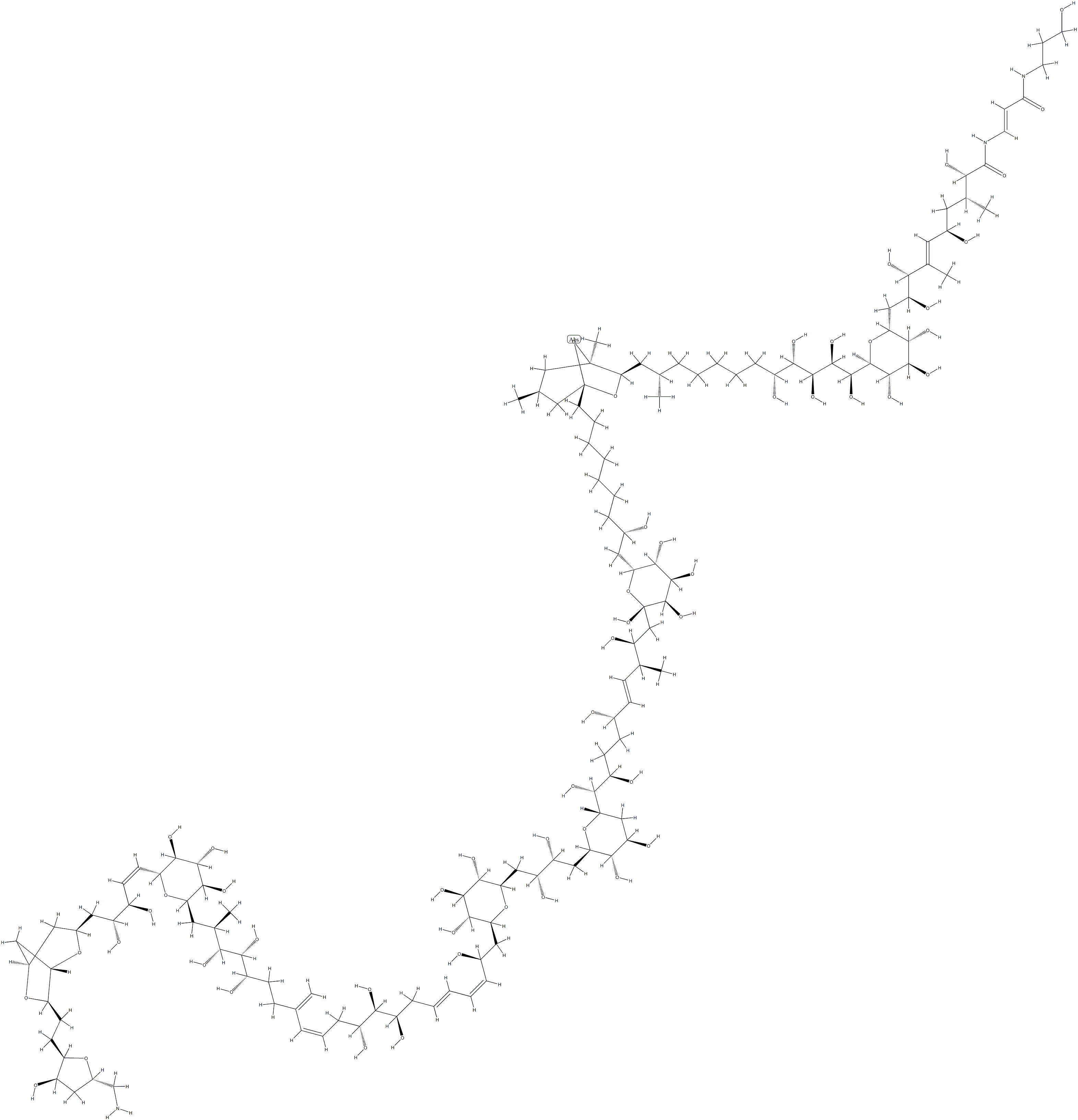PALYTOXIN
- CAS No.
- 11077-03-5
- Chemical Name:
- PALYTOXIN
- Synonyms
- PTX;PALYTOXIN;Palytoxin, Palythoa toxica;(C52-55-HEMIACETAL) PALYTOXIN;palytoxin from palythos caribaerum;Palytoxin from Palythoa caribaeorum;Palytoxin (C44-C47-hemiacetal, 43,47-anhydro)
- CBNumber:
- CB6669355
- Molecular Formula:
- C129H221N3O53
- Molecular Weight:
- 2662.12
- MDL Number:
- MFCD00131785
- MOL File:
- 11077-03-5.mol
| Density | 1.374±0.06 g/cm3(Predicted) |
|---|---|
| storage temp. | −20°C |
| FDA UNII | OQ17NC0MOV |
SAFETY
Risk and Safety Statements
| Symbol(GHS) |  GHS06 |
|---|---|
| Signal word | Danger |
| Hazard statements | H310-H330-H300 |
| Precautionary statements | P262-P264-P270-P280-P302+P350-P310-P322-P361-P363-P405-P501-P264-P270-P301+P310-P321-P330-P405-P501-P260-P271-P284-P304+P340-P310-P320-P403+P233-P405-P501 |
| Hazard Codes | T+ |
| Risk Statements | 26/27/28 |
| Safety Statements | 53-22-36/37/39-45 |
| RIDADR | UN 2811 6.1/PG 1 |
| RTECS | RT6475000 |
| Toxicity | skn-rbt 250 ng/4M MOD TOXIA6 12,427,74 |
PALYTOXIN Chemical Properties,Uses,Production
Definition
ChEBI: Palytoxin is a polyol marine coelenterate toxin composed of substituted N-3-hydroxypropyl-trans-3-amidoacrylamides and produced by species of Palythoa and Zoanthus soft corals (collectively called zoantharians), either as a defence mechanism or to assist them in capturing prey. An ionophore that forms cation channels through Na+/K+-ATPase, it is a potent vasoconstrictor useful in evaluation of anti-angina agents. It is considered to be one of the most poisonous non-protein substances known, second only to maitotoxin in terms of toxicity in mice. It has a role as a toxin.
Safety Profile
A deadly poison by intraperitoneal, parenteral, subcutaneous, intravenous, intramuscular, and intratracheal routes. A skin and severe eye irritant. When heated to decomposition it emits toxic fumes of NOx.
Enzyme inhibitor
This structurally complex neurotoxin (FW = 2680.17 g/mol; CAS 11077- 03-5; Abbreviation: PLTX), from the Pacific soft coral Palythoa toxica, binds slowly, but with extreme affinity, to Na+/K+-exchanging ATPase, converting the latter into an open channel, allowing unhindered passage of potassium and sodium ions. Less than 1 pM palytoxin is required for rapid potassium ion outflow from erythrocytes, thereby dissipating its transmembrane electric potential. Palytoxin is lethal in mice, exhibiting an impressive LD50 of 15 ng/kg. The pore-forming action of palytoxin is not restricted to Na+/K+-ATPase, but is also observed with the colonic H+/K+-ATPase. This observation raises the likelihood that the toxin reacts at functionally and/or structurally similar manner with these pumps. PLTX brings about depolarization of the cellular membrane, disrupting intracellular calcium concentration ([Ca2+]i) and leading to smooth and cardiac muscle contraction, cytoskeletal dysregulation, and neurotransmitter release. Second only to maitotoxin as the most toxic natural product known, palytoxin evokes prompt onset of severe agina and asthma-like airway effects, followed quickly by tachycardia and death, often within minutes. SKF-96365 and Gd3+ are widely used to block store- operated and stretch-activated Ca2+ channels, respectively. SKF-96365 fails to affect the long-lasting phase elicited by PLTX, excluding the activation of the store-operated channels during this phase. In contrast, Gd3+ abolishes the long-lasting phase of the [Ca2+]i increase, suggesting a possible role for stretch-activated channels in PLTX action. While Gd3+ is also known to inhibit voltage-dependent Ca2+ conductance in neural cells, voltage-dependent Ca2+ blockade seems unlikely in muscle cells. Even at a level (100 μM) commonly used to investigate stretch-activated channels activity, Gd3+ does not affect the transient phase as Verapamil and La3+/Cd2+ does. In addition to the selective inhibitory action of Gd3+ on the long- lasting phase, Gd3+ also significantly reduces, albeit incompletely, the toxic effects of PLTX on skeletal muscle cells, suggesting a role for the stretch- activated channels in the chain of events culminating in death of cultured muscle cells. Palytoxin also binds to erythrocyte Band-3 protein (B3 or AE1), altering the anionic flux and seriously compromising not only CO2 (bicarbonate) transport, thereby also affecting hemoglobin oxygenation/deoxygenation. The stereocontrolled synthesis of palytoxin was heralded as one of the most complicated syntheses ever undertaken. (See Maitotoxin)
PALYTOXIN Preparation Products And Raw materials
Raw materials
Preparation Products
PALYTOXIN Suppliers
| Supplier | Tel | Country | ProdList | Advantage | |
|---|---|---|---|---|---|
| Riedel-de Haen AG | -- | United States | 6825 | 87 | |
| SIGMA-RBI | -- | Switzerland | 6913 | 91 |
| Supplier | Advantage |
|---|---|
| Riedel-de Haen AG | 87 |
| SIGMA-RBI | 91 |
11077-03-5(PALYTOXIN)Related Search:
1of4





